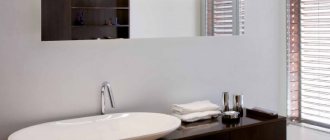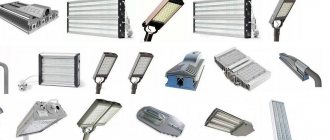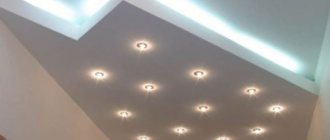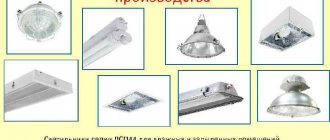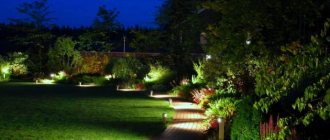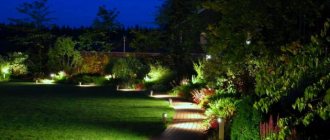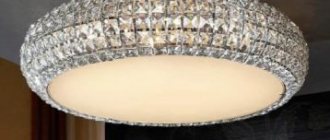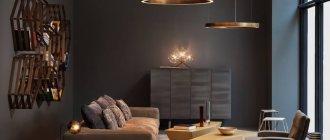Not everyone knows about the features of bathroom lighting, what the pitfalls are and how to properly ensure safety. First of all, protection from moisture is very important in this room. And it is not surprising, because such a lamp is, first of all, an electrical device, the operation of which is associated with certain risks. And the humidity level in the bathroom is always high. Moreover, even in the case of high-quality modern repairs, it is not possible to overcome excessive humidity, so the contacts must be protected so that the lamps are safe, durable and functional. So, today we will talk about lamps for the bathroom, consider their types and selection criteria, and also do the installation yourself. But first things first.
Spotlights for the bathroom
Note! Lighting fixtures for the bathroom must be waterproof - there is no place for ordinary light bulbs and primitive sockets. But the average consumer, alas, does not always understand all these subtleties. As a result, for a room where temperature/humidity changes are constantly observed, and steam is often more like a curtain, ordinary lamps are purchased. Except that the power is greater, and the dimensions are smaller. However, this approach is fundamentally wrong!
The bathroom is a room with high humidity levels
No. 1. How many lamps will be needed?
The number of lighting fixtures in the bathroom depends directly on its area . If the room is very tiny , and its area is about 5 m2, then a chandelier in the center of the ceiling with two or three lamps will be enough. But even if the bathroom is small, it is better to additionally illuminate the washbasin and mirror area to make all cosmetic procedures much easier.
If the bathroom is spacious enough , then it is necessary to provide zone lighting, the features of which will depend on the configuration of the room, design ideas and some other factors.
It is important to consider a lot of other factors that affect the lighting in the bathroom. These include:
- interior style , or rather the chosen color scheme, because, as you know, light shades reflect light fluxes more, which means the room will seem more illuminated. The same can be said about glossy, mirror and glass surfaces;
- the height at which the lamps will be installed , because the closer they are to a person, the brighter the light they give;
- type of lamps.
It is better to decide on the number and location of lighting fixtures at the stage of repair work in order to avoid unnecessary hassle and waste in the future.
No. 2. What type of lamp should I choose?
Today, the choice of lighting devices is so extensive that everyone can choose the option that best suits their wishes. So, according to the type of location on the surface, lamps can be:
- open;
- built-in This option is preferable for miniature bathrooms with not very high ceilings.
Depending on the location, the lamps can be:
- ceiling _ This is a timeless classic. Each bathroom should be equipped with at least one ceiling lamp, which will be responsible for the general light in the room;
- wall- mounted These are lamps that are designed to highlight certain functional areas of the room;
- floor lamps perform more of a decorative function; they can add zest to the interior of a room and visually expand the space of the room.
Each of the lamps used can perform one or several of the following functions :
- work lighting;
- decorative lighting;
- directional lighting;
- general lighting.
, different types of lamps can be used as light sources :
- incandescent lamps;
- halogen;
- luminescent;
- LED
Everyone has the right to choose the type of lamps themselves, depending on the type of lamp or their own desire to save money, but special attention should be paid to LED lamps . They are considered the most economical and safe, because they do not heat up during operation. LED strip is also often used , which brings real zest to the bathroom interior. The only drawback of LED lamps is their high price.
Approximate installation plan
Prepare your tools in advance. You will need:
- knife for cutting ceiling film;
- fishing line;
- soft lead;
- glue for PVC surfaces;
- drill;
- dowels;
- screws;
- roulette;
- a set of tools for electrical installation;
- metal fasteners for drywall.
First, markings are carried out for future lamps. Then the decorative fabric or structure made of plastic panels is secured. This stage is especially important when installing multi-level stretch ceilings. Place the lamps so that there is a distance from the walls of at least 60 cm. The distance between lighting devices should not be less than 1 m. Mounting points for lamps should not be placed on base moldings. Leave a gap of 25-30 cm. Place lamps on slatted ceilings so that they do not fall on the joints.
If you intend to install a chandelier, move additional light sources closer to the walls. This will allow you to create a different environment in the room when using different lamps. If the bathtub is separated from the rest of the room by a curtain, it may be dark. Install a separate light bulb to avoid this.
Then adjustable racks are installed. Fix the mortgages so that they do not create obstacles when installing the stretch ceiling. Dowels and screws are used for fixation.
Then electrical installation work is carried out. The cable must be laid and secured near each future light source. When the work is completed, the ceiling covering is installed.
After this, they move on to attaching the lamps. A round mounting profile is glued in pre-designated areas. Holes are made in the canvas from the inside. Cut clearly and carefully so as not to spoil the material.
The mounting posts are located at the same level as the ceiling. Electrical conductors are led out through the hole. Install a thermal insulation ring to avoid overheating of the film. Connect the wires and complete the light installation.
If you are going to connect the LED strip, run the cable under it.
No. 3. How to properly place light sources in the bathroom?
choosing the location of lighting fixtures in the bathroom very carefully Experience suggests that you need to take into account some nuances , including:
- lighting must be uniform , so you should always take into account the following rule. The more light sources in the room, the lower their power should be;
- light should be properly distributed, and lamps should be located in all functional areas of the bathroom;
- it is important to avoid glare , and for this you should not direct the lamps perpendicular to reflective surfaces: it is better if they are located at an angle;
- A common mistake is to place one lamp directly above the mirror. Often in this case the reflection will be slightly distorted. It is better to use mirror lighting on the sides, or top and sides;
- zest can be added to the interior thanks to color spots : colored lampshades, original ceramic tile inserts. But it is better not to place such details in the area of the mirror, so as not to distort the reflection;
- Those who like non-standard ideas can be advised to experiment with the location of the LED strip: it can be placed under the side of the bathtub, under the window sill, etc.;
- It is better to connect different lamps in the bathroom using separate lines , because not every time you will need to turn on all the lighting at once.
Types of lamps
Bathroom lamps are available with all the usual types of lamps. But not all types are well suited to wet rooms.
Incandescent
Not the best solution for a bathroom. Suitable for use only in the last zone, farthest from water, splashes. A sealed protective cover is required.
pros
- low prices;
- widespread in stores;
- resistance to voltage surges.
Minuses
- fragility, mechanical instability;
- strong heating during operation: up to approximately 250⁰ C and higher. Accidental entry of moisture will result in an explosion;
- short service life (1000 hours);
- They only shine with warm light.
LED
Most suitable for damp areas. Available in the form of lamps, spots, and strips of different designs. Their use is possible in all areas of the room.
pros
- moisture resistance;
- efficiency, energy saving;
- environmental Safety;
- absence of strong heating of the lamp: LED heats up to approximately 60-80⁰С;
- variety of glow colors, color temperatures;
- long service life (approximately 30,000 hours and above);
- Possibility of programming lighting modes.
Minuses
- high price;
- decrease in brightness over service life due to physical degradation of LEDs;
- reduction in manufacturing quality due to high competition among manufacturers and the desire to reduce prices.
Halogen
Can be used as spotlights with the appropriate protection class. In areas directly in contact with water, it is better to install a low-voltage version of lamps: with a supply voltage of 12 V. Acceptable, but not the best option.
pros
- relatively low price;
- good quality of light;
- variety of shapes and appearance of lamps.
Minuses
- short service life (2000-4000 hours);
- sensitivity to voltage changes in the network;
- strong heating during operation: up to 300⁰С.
Luminescent
The worst option for use in the bathroom. Fluorescent lamps are afraid of high humidity and frequent switching on and off, which is typical for the bathroom. Other disadvantages worth noting:
pros
- long service life (10,000-15,000 hours);
- save energy;
- have a variety of color temperatures.
Minuses
- environmental hazard due to the presence of mercury vapor in the composition;
- difficulties with recycling used lamps;
- sensitivity to voltage changes in the network.
No. 4. The need for ceiling lighting
As already mentioned, one source of lighting is not enough even in the smallest bathroom. The function of general lighting is usually performed by ceiling lamps, which must be present in the bathroom. So, for ordinary ceilings it is better to choose a chandelier, and for pendant ceilings you can use recessed lamps. It is also worth considering the height of the room, and do not place long chandeliers in low rooms. An excellent option is a spotlight lamp , the direction of the light of which can be adjusted to obtain a sufficient level of illumination in any area of the room.
The shape, design and color of lighting fixtures can be very different, and here the choice should be based on personal preferences, the design of the room, but not forgetting about functionality.
Features of lighting organization
When planning the installation of artificial light devices for a bathroom in which a suspended ceiling is installed, it is important to consider the following points:
- this is a room with high humidity, so the lighting fixture must be waterproof so that both the lamp and the luminaire last longer;
- Regardless of whether the room is large or small, zoning is organized in it, and for this purpose, a different type of bathroom lamp is often used in each zone. The photo shows the organization of zoning of a hygienic room with light sources;
Bathroom - zoning with light sources
- according to the international standard ISO 8995, the hygiene room must have lighting of 200 Lux, and the lighting device must be selected taking this indicator into account;
- This room most often does not have windows, and there is no natural light in it, so the lamp is the main source of light.
No. 5. What functional areas should be highlighted in the bathroom?
If your bathroom is quite spacious, then you need to select several zones with their own lighting:
- wash area, where, naturally, the washbasin and mirror are located;
- bathing area with bath or shower;
- a free area for changing clothes, folding things or doing laundry.
In addition, pieces of furniture can also be illuminated : shelves, cabinets, bedside tables can have small built-in lamps that provide soft, unobtrusive light that can illuminate the entire contents of the cabinet and make it easier to find the necessary item.
No. 6. Mirror and washbasin lighting
The mirror needs to be illuminated so that the reflection in it is as natural as possible, without unnecessary shadows and does not distort the colors. In this case, it is better to refuse lamps under the mirror, as well as colored lighting, which will create unnecessary color spots on your reflection. It is better if the light is as soft as possible , so the lampshades can be matte or white. The best option is to place light sources on the sides or along the perimeter of the mirror. Lamps can be used of absolutely any type, but it is better that the resulting light is as close as possible to natural daylight.
Location of lighting fixtures
The lighting is evenly placed around the perimeter of the room so as not to strain a person’s vision. Therefore, even in a small bathroom, main and task lighting are combined.
In the loft style you can use ordinary incandescent lamps
Illumination of zones also requires the right approach. Lamps above the mirror are mounted in the ceiling; sometimes a strip of LEDs is purchased for the mirror.
The shower area is not always illuminated with light; this is decided by the owner himself.
Quite often, lamps come with a shower stall. Wall sconces and spots are selected for the bathroom. You can illuminate the shower niche or even the floor.
Comfortable lighting location option:
- along the perimeter of the room;
- use of combined lighting;
- symmetrical mounting on walls and ceilings;
- separate lighting for each zone.
No. 7. Bath or shower lighting
Bathroom lighting is not mandatory; rather, it serves a purely decorative role , creating a cozy and relaxing atmosphere. So, you can find several lamps in the shower, hang several sconces above the bathtub, or even organize bottom lighting in the bathtub. Everyone has long known that taking a bath is more of a relaxation than a hygienic procedure, and appropriate lighting can make such a relaxation even more comfortable.
No. 8. Possibilities of decorative lighting
For fairly spacious bathrooms with interesting architectural details, you can use lighting that does not have any direct function, but is intended only to decorate the interior and create a unique atmosphere. You can highlight anything: steps, niches, windows, other elements of the room . Today there are even tiles that have LEDs built into them.
Separately, it should be noted floor lighting : to create it, durable lamps are used, such as for garden paths, and their power should be no more than 5 W. With their help, you can create a unique interior and visually expand the boundaries of the bathroom.
No. 9. Safety regulations
Where electricity and humidity meet, there is an increased risk of unforeseen conditions that can be dangerous. That is why when choosing, installing and using lighting fixtures in the bathroom you need to adhere to a number of rules:
- correctly develop a bathroom lighting scheme, and this task can be entrusted to professionals;
- It is necessary to use only those lamps that are resistant to moisture;
- metal parts of lamps must be protected from corrosion;
- lighting fixtures in the bath and shower should have a power of no more than 12 W;
- You cannot place sconce lamps directly above the bathroom;
- The risk of water entering wall or ceiling lighting fixtures should be minimal. There is no place for open incandescent lamps in the bathroom at all, since if drops of water get on the heated glass, the lamp may even burst, and glass fragments will scatter throughout the room;
- There is no place for exposed wiring, extension cords, or tees in the bathroom.
In conclusion
Bathroom lighting is a detail that performs several functions at once, and therefore the approach to organizing lighting requires taking into account a variety of factors: the type and power of the lighting fixture, location, safety, design, etc. With all this, it is important not to forget about safety precautions both at the stage of repair work and in the future. Remember that thanks to lighting you can create not only a comfortable, but also a cozy space.
The article was written for the site.
Tags:Bathroom, Lighting systems
How to install correctly
Markings are made on the ceiling or wall for the placement of fixtures for lamps. Wall lighting is secured using dowels or self-tapping screws. Lightweight or plastic devices are installed on wooden or plasterboard panels. The wiring is secured with hooks and masked with an overhead casing.
Installation must be carried out in compliance with safety precautions
Marking of lamps on a suspended ceiling is done before installing the canvas. Carry out wiring to the mounting points. Then the ceiling is stretched on the front side of which the symmetrical arrangement of devices is marked with a ceiling laser.
A plastic lining is attached to the marking site, thanks to which the fabric will not go along the seams when cutting holes. The lamp body is inserted into the cut-out hole by connecting the wires to the socket. Next, screw in the light bulbs and seal them with an airtight coating.
To install the lamps, you need to turn off the power to the entire apartment and work with rubber gloves.
